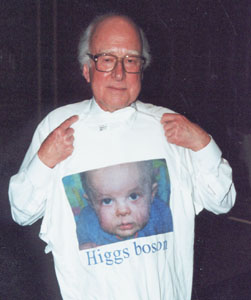

As part of the recent UK Institute of Physics conference, Particle Physics 2000, in Edinburgh, a special symposium was held to celebrate the 70th year of Peter Higgs, after whom the elusive “Higgs field” is named. This field and its particles are responsible for the spontaneous symmetry breaking of the symmetry of electroweak interactions, so that, for example, the W and Z carriers of the weak force are heavy particles, while the electromagnetic photon remains massless. Finding the Higgs particle(s) is today’s major particle physics goal.
The event opened with a talk by current Nobel prizewinner Gerard ‘t Hooft on the early days of gauge theories, in which he reminded the audience that in the 1960s these theories were widely regarded as of little relevance to particle physics. However, his supervisor, Martinus Veltman, insisted that all of his students read an obscure paper from the 1950s by Yang and Mills, so helping the 1970s resurgence of gauge field theories.
In the following talks, Peter Zerwas (DESY) reviewed the phenomenology of the Higgs particle at current and future colliders, and Pedro Texeira-Dias (CERN) described the current experimental search for the Higgs at LEP.
The afternoon concluded with a lively talk by former CERN director-general Chris Llewellyn Smith on his long association with the search for the Higgs boson, which began as the theory convenor of a workshop in 1980. He gave a vivid description of the physics involved in engineering the LHC collider, including a picture of the CERN administration building apparently “relocated” to one of the LHC experimental caverns. He had used this to show the CERN Council how big the pits needed to be, and was asked why he wanted to move the administration building to the pit!
A theme of the meeting was that the Higgs is everywhere. In a public lecture by Frank Close on the origins of asymmetry, Higgs was seen to break the symmetry of an empty Coke can on which Close was balancing, causing Close’s potential to collapse into an asymmetric state.
At the banquet, Ken Peach, director of particle physics at Rutherford Appleton Laboratory, gave a lecture from the pulpit of the former Highland Kirk. In this suitably Calvinist setting, he recalled his misspent youth as a student in Edinburgh, but seemed to remember attending a few field theory lectures by Higgs, which may account for his subsequent career. More recently he recalled an L3 speaker giving a seminar in Edinburgh describing the failure to find a Higgs at LEP, at the end of which it was pointed out that there was in fact a Higgs in the audience.
However, the most moving part of the Fest belonged to Higgs, who sported a T-shirt of his grandson, indicating the existence of a second light Higgs (evidence for super-symmetry?). He received an honorary fellowship of the Institute of Physics, and a piece of an LHC magnet from his colleagues, to which he responded in typically modest fashion. Apparently the famous Higgs particle was the result of only three weeks’ work in the mid-1960s. The first two weeks were spent writing a paper and having it rejected by the referee on the grounds that quantum field theory was obscure and of little interest. The referee suggested that the paper might be improved by the addition of some practical consequences of the theory. The third week was spent providing these examples, which included the Higgs particle. The audience, which included a large fraction of graduate students, was suitably awestruck by the idea that a mere three weeks’ work might be sufficient to get a particle named after you.





